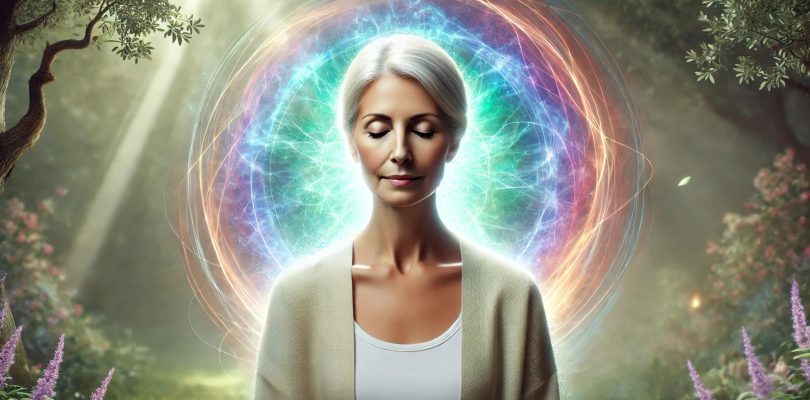Every living being radiates energy, and this energy is often expressed through what is known as an aura—a luminous field that surrounds the body. Auras are made up of different colors that can reflect your emotional, spiritual, and physical state. Whether you’ve noticed a particular color in meditation, had your aura read, or simply feel curious about energy fields, understanding your aura color can offer deep insights into your well-being, personality, and life path.
In this guide, we’ll explore what aura colors are, the significance of different colors, and how you can interpret your own aura. Whether you’re a beginner just learning about energy work or someone seeking to deepen your spiritual practice, this article will help you unlock the mysteries of your aura and what it says about you.
What Is an Aura?
An aura is often described as a glowing light or energy field that surrounds a person, reflecting their emotional, spiritual, and physical states. Auras are invisible to most people, but certain individuals with heightened sensitivity can perceive them. While the concept of auras has roots in ancient spiritual traditions, modern practitioners often use them as tools to gain insight into a person’s overall energy and well-being.
Each aura consists of several layers that radiate outward from the body. These layers, often referred to as the physical, emotional, mental, and spiritual layers, each carry specific energies. The colors within an aura can change based on a person’s thoughts, emotions, and spiritual development, and no two auras are exactly the same.
Why Is Understanding Your Aura Color Important?
Understanding your aura color can give you valuable insights into your emotional and spiritual health, relationships, and even your life purpose. Your aura color reflects what is happening within you on a deeper level. For example, a person with a bright yellow aura might be full of optimism and creative energy, while someone with a deep blue aura may be more introspective and spiritually connected.
By learning to interpret your aura, you can become more aware of your internal states, allowing you to recognize when something is off-balance. This self-awareness can help you make positive changes in your life, whether that means addressing emotional blockages, adjusting your spiritual practice, or focusing on physical healing.
How Are Aura Colors Interpreted?
Each aura color has its own unique meaning, and the different shades of these colors can offer additional nuances. Some colors indicate strength and vitality, while others may suggest challenges or areas where healing is needed. It’s also common for someone’s aura to contain more than one color, representing different aspects of their energy at a given time.
Let’s explore the main aura colors, what they represent, and how they might manifest in your life.
The Meaning of Common Aura Colors
1. Red Aura: Energy and Passion
Red is one of the most vibrant and dynamic aura colors. It is associated with energy, strength, passion, and grounding. A person with a red aura is often action-oriented, ambitious, and driven to achieve their goals. Red can also indicate a strong connection to the physical world and a grounded approach to life.
However, a red aura can sometimes indicate anger or aggression if it appears in a dark or murky shade. It may suggest that the person is dealing with unresolved emotions, frustration, or stress.
Example: If you’re currently in a phase of intense activity, working on new projects or pursuing personal ambitions, you might notice your aura taking on a strong red hue, indicating vitality and drive.
2. Orange Aura: Creativity and Sociability
Orange is the color of creativity, joy, and emotional balance. It represents a person who is enthusiastic, sociable, and able to express their emotions openly. People with an orange aura tend to be energetic and adventurous, often seeking new experiences and connections with others.
On the flip side, too much orange can indicate emotional overwhelm or anxiety, particularly if someone is struggling to maintain balance in their relationships or personal life.
Example: If you’ve recently been collaborating on a creative project or enjoying time with friends, you may notice an orange aura reflecting your sociability and emotional warmth.
3. Yellow Aura: Optimism and Mental Clarity
A yellow aura is bright, joyful, and filled with optimism. It signifies a person who has a positive outlook on life, strong mental clarity, and a desire for learning and growth. People with yellow auras are often intellectual, curious, and enthusiastic about their pursuits. This color is also closely linked to the Solar Plexus Chakra, which governs confidence and personal power.
A dull or muddy yellow aura can indicate self-doubt, confusion, or mental fatigue.
Example: If you’re feeling confident, mentally clear, and excited about your goals, your aura might shine with a vibrant yellow, reflecting your optimistic state.
4. Green Aura: Healing and Compassion
Green is the color of healing, balance, and compassion. It’s closely associated with the Heart Chakra, which governs love and emotional well-being. A person with a green aura is often a natural healer, empathetic, and deeply connected to nature and those around them. They exude a calming and nurturing energy, making them great friends, partners, or caregivers.
However, a dark green aura may suggest feelings of jealousy or possessiveness, or it could indicate that the person is overly focused on others’ needs to the detriment of their own.
Example: If you’ve been practicing acts of kindness or engaging in self-care, a vibrant green aura may surround you, reflecting your compassion and healing energy.
5. Blue Aura: Intuition and Communication
A blue aura is connected to intuition, communication, and spiritual awareness. People with blue auras are often calm, peaceful, and thoughtful, with a deep sense of inner wisdom. Blue is also tied to the Throat Chakra, indicating clear communication and honesty.
A bright blue aura suggests that someone is aligned with their truth and able to communicate effectively. However, a darker or murkier blue can suggest a blockage in communication or feelings of isolation.
Example: If you’ve been meditating or connecting with your spiritual side, you might find a bright blue aura reflecting your deepened sense of intuition and inner peace.
6. Purple Aura: Spirituality and Intuition
Purple is the color of spirituality, psychic ability, and deep insight. It’s connected to the Crown Chakra, which governs spiritual enlightenment and connection to higher consciousness. People with a purple aura are often spiritually evolved, with a strong intuition and a deep understanding of the universe.
A purple aura can also suggest that someone is undergoing a period of spiritual growth or awakening.
Example: If you’re on a spiritual journey or exploring new levels of consciousness, you may notice your aura taking on a purple hue, symbolizing your heightened spiritual awareness.
7. White Aura: Purity and Divine Connection
A white aura is rare and represents purity, wisdom, and a strong connection to the divine. It’s often seen in individuals who are spiritually enlightened or have a deep connection to their higher self. A white aura reflects a state of balance and harmony with the universe.
While it’s less common, a white aura can sometimes suggest that a person is very sensitive to external energies, making them vulnerable to feeling drained or overwhelmed.
Example: If you’re going through a period of deep spiritual connection or purification, you may find your aura glowing white, signifying a high level of spiritual clarity.
8. Pink Aura: Love and Affection
Pink is a color that represents unconditional love, kindness, and affection. People with a pink aura are often nurturing, loving, and deeply caring. This color is associated with the Heart Chakra and indicates someone who has a deep capacity for compassion and is often focused on creating harmony in their relationships.
A pink aura suggests a person who is generous with their love and energy, but it can also indicate that they may need to focus on self-love and setting boundaries if the pink appears overly bright or “drained.”
Example: If you’ve been focused on your relationships, showing love and support to others, you might notice a pink aura, indicating your nurturing spirit.
How to See and Interpret Your Aura
While some people naturally see auras, others may need to practice to perceive them. If you want to understand your aura color, here are a few methods you can try:
1. Aura Meditation
One of the most effective ways to connect with your aura is through meditation. Sit quietly in a comfortable space and close your eyes. Take a few deep breaths to center yourself, then visualize the energy surrounding your body. Try to focus on the colors you sense around you. With practice, you may start to perceive your aura color more clearly.
2. Mirror Method
Another way to see your aura is to stand in front of a mirror in a well-lit room. Focus on the space just around your body, particularly near your shoulders and head. Relax your eyes and try not to focus too hard. Over time, you may start to notice a faint glow or color surrounding your body.
3. Seek a Professional Aura Reader
If you’re having difficulty seeing your own aura, you can consult with a professional aura reader who is trained in perceiving and interpreting aura colors. They can give you detailed insights into your current energy state and what your aura colors say about you.
How to Cleanse and Balance Your Aura
Just like chakras, your aura can become blocked or clouded by negative emotions, stress, or external influences. Regularly cleansing and balancing your aura can help you maintain optimal energy flow and overall well-being. Here are a few simple methods to cleanse your aura:
1. Smudging with Sage
Burning sage, also known as smudging, is a powerful way to cleanse negative energy from your aura. Simply light the sage bundle and gently waft the smoke around your body, focusing on areas that feel heavy or blocked.
2. Salt Baths
A bath infused with sea salt or Epsom salts is an excellent way to cleanse your aura. Salt helps to draw out negative energy and restore balance. As you soak in the bath, set the intention to release any stagnant or negative energy.
3. Energy Healing
Energy healing practices such as Reiki or crystal healing can also help to clear blockages in your aura and restore balance. Working with a practitioner can give you the added benefit of guided healing and insight into specific areas that need attention.
Final Thoughts: Understanding Your Aura Color
Understanding your aura color can offer profound insights into your emotional, mental, and spiritual health. By becoming aware of the energy you radiate, you can gain a deeper understanding of your strengths, challenges, and areas of growth. Whether you’re learning to see your own aura or seeking guidance from an experienced practitioner, exploring your aura is a valuable tool for self-awareness and healing. Regularly tuning in to your aura can help you maintain balance, release negative energy, and foster a deeper connection to your true self.



